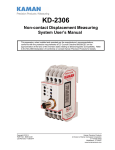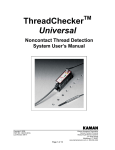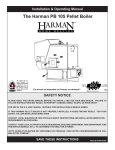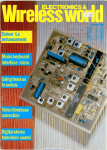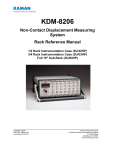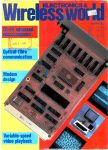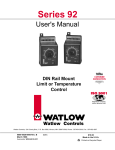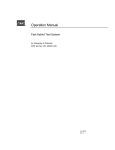Download Kaman KDM-8200 Instruction Manual
Transcript
KDM-8200 • EuroCard • Noncontacting • Displacement Measuring System Instruction Manual EC DECLARATION OF CONFORMITY This apparatus, when installed and operated per the manufacturer’s recommendations, conforms with the protection requirements of EC Council Directive 89/336/EEC on the approximation of the laws of the member states relating to Electromagnetic Compatibility, as required by the Technical Construction File Route to Conformity. This certificate has been issued in accordance with the conditions of regulation No. 53 of U.K. Statutory Instruments 1992 No: 2372 – The Electromagnetic Compatibility Regulations. ******** Do not make any modifications to cable length, sensor or calibrated target materials without prior consultation with a Kaman application engineer. ******** Copyright © 2000 PART NO: 860059-001 Rev. F Kaman Precision Products | Measuring Warranty Kaman Precision Products Standard Limited Warranty Products of Kaman Precision Products are warranted to be free from defects in materials and workmanship when installed and operated in accord with instructions outlined in the instruction manual. Kaman Precision Products's obligation under this warranty shall be limited to repair or replacement (at the discretion of Kaman Precision Products) of the defective goods returned to Kaman's plant within one (1) year from date of shipment. Extreme environment sensors are limited to the maximum operating temperature as specified within the most current Kaman Extreme Environment Systems data sheets. This warranty is valid except when the products have been subject to misuse, accident, negligent damage in transit or handling, or operation outside the conditions prescribed in the data sheet or instruction manual. This will be determined by Kaman Precision Products personnel. In no event shall Kaman be liable for incidental or consequential damages, including commercial loss, resulting from any article sold under this Agreement. In the event Buyer fails to limit to Kaman's warranty set forth above, any express or implied warranty Buyer may make with respect to any product of which any article sold there under is a component, Buyer shall indemnify and hold Kaman harmless from any and all liability, costs and expenses to which Kaman may be subjected as a result of Buyer's failure to so limit its express or implied warranties. THIS WARRANTY IS EXCLUSIVE AND IS MADE IN LIEU OF ALL OTHER WARRANTIES; AND THOSE IMPLIED WARRANTIES, INCLUDING SPECIFICALLY THE WARRANTIES OR MERCHANTABILITY AND FITNESS FOR A PARTICULAR PURPOSE ARE HEREBY EXPRESSLY LIMITED TO ONE (1) YEAR DURATION. NO MODIFICATION OR ALTERATION OF THE FOREGOING WARRANTY AND LIMITATION OR REMEDIES PROVISIONS SHALL BE VALID OR ENFORCEABLE UNLESS SET FORTH IN A WRITTEN AGREEMENT SIGNED BY KAMAN AND THE BUYER. Kaman Precision Products Warranty No. 7A 2 Kaman Precision Products Customer Service Information Should you have any questions regarding this product, please contact an applications engineer at Kaman Precision Products Operations 719-635-6979 or fax 719-634-8093. You may also contact us through our web site at: www.kamansensors.com. Service Information In the event of a malfunction, please call for return authorization: Customer Service/Repair Kaman Precision Products Operations: 860-632-4442 3 Kaman Precision Products Table of Contents WARRANTY CUSTOMER SERVICE INFORMATION INTRODUCTION Welcome…………………………………………………………………………………… 10 Cautions and Safeguards…………………………………………………………………… 10 Using this Manual………………………………………………………………………….. 11 Icon Directory………………………………………………………………………………. 11 PART 1: WHAT IS THE KDM-8200? System Technology………………………………………………………………………... 14 System Configurations………………………………………………..……………………. 15 PART 2: GETTING STARTED Inventory and Set-up………………………………………………………………….……. 18 PART 3: THE EQUIPMENT Series 8000 Enclosures……………………………………………………………………. 22 EuroCard Module…………………………………………………………………………... 25 Optional Function Modules………………………………………………………………... 25 System Modifications……………………………………………………………………… 25 Power Supply………………………………………………………………………………. 25 Wiring……………………………………………………………………………………… 26 Sensors Specification………………………………………………………………………. 27 Measuring Range…………………………………………………………………………... 27 Sensor Mounting…………………………………………………………………………… 28 Conductive vs. Nonconductive……………………………………………………………. 28 Simulated vs. Application Fixture…………………………………………………………. 28 Conductive Materials in the Measuring Area……………………………………………… 28 Surface Mounting………………………………………………………………………….. 29 Flush Mounting…………………………………………………………………………….. 29 Target Material…………………………………………………………………………….. 30 Target Size…………………………………………………………………………………. 30 Target Thickness…………………………………………………………………………… 31 Other Considerations………………………………………………………………………. 31 PART 4: CALIBRATION Factory Calibration………………………………………………………………………… 34 Dimensional Standards…………………………………………………………………….. 34 Offset………………………………………………………………………………………. 34 Sensitivity………………………………………………………………………………….. 35 When is the System Fully Calibrated?……………………………………………………... 35 Calibration Controls……………………………………………………………………….. 35 Test Points…………………………………………………………………………………. 35 Zero Control……………………………………………………………………………….. 36 Gain Control……………………………………………………………………………….. 36 Linearity……………………………………………………………………………………. 37 The Three Calibration Methods……………………………………………………………. 37 Full Scale Calibration Procedure…………………………………………………………... 38 Alternate Bipolar Output Calibration……………………………………………………… 40 High Accuracy Band Calibration Procedure………………………………………………. 40 PART 5: APPENDICES A. Glossary………………………………………………………………………………... 43 B. System Modifications………………………………………………………………….. 47 C. Troubleshooting………………………………………………………………………... 51 4 Kaman Precision Products Introduction Welcome Cautions and Safeguards Using this Manual Icon Directory 5 Kaman Precision Products Introduction Welcome Welcome to the Series 8000 by Kaman – a family of precision EuroCard, noncontact displacement measuring systems designed to solve a wide variety of position measurement problems. This instruction manual is a valuable part of your precision measurement toolbox. It is intended to simplify your use of the KDM-8200 measurement system whether you are new to Kaman systems or a veteran user. In addition to the precision measuring channels, other special function modules, such as a summation/comparator, and voltage to current converter are available. Each is described thoroughly in its supplemental instruction manual. The information in this manual contains everything you need to know to optimize system performance. Any optional function cards you choose will come with their own instruction manual to supplement the information contained here. If after reviewing this manual you need additional information or assistance specific to your application, please call us a (800) 552-6267. Cautions and Safeguards 6 This information contains important cautions and safeguards associated with the use of the KDM-8200 system. Please read the list carefully before working with the system. • To protect against risk of electrical shock, do no place the system module in water. • Do not operate with a damaged power cord. • Do not let power cords or sensor cables touch hot surfaces. • Do not let power cords or sensor cables hang where someone might trip on them. • Unplug all power supplies before attempting to make any system modifications. • Do not expose system modules to excessive heat or moisture. • Be careful not to break the glass on the display module. Kaman Precision Products Introduction Using this Manual Our goal is to have you taking measurements as quickly and easily as possible regardless of your familiarity with our systems. This is a do-it-yourself manual, allowing you to work and learn at your own pace. Depending upon the amount of background information you need to complete each step. You can find as much or as little information as you need: • • • • • PART 1: An introduction to our technology, system configuration, and chassis enclosure. PART 2: System inventory and set-up. PART 3: Detailed considerations and explanations of system operation and configuration. PART 4: Calibration PART 5: Appendices containing a glossary, supplementary material on troubleshooting and system modifications. All users, despite their level of expertise, should do the following before attempting to use the KDM-8200 system. • • • Icon Directory 7 Familiarize yourself with the icons defined below. They will appear throughout the manual. Inventory the system. Refer to Part 3: EQUIPMENT on sensors and targets, and Part 4 CALIBRATION for a detailed discussion of the considerations involved in making the right choices for your specific application. A variety of symbols, called icons, appear throughout this instruction manual to call your attention to information requiring special consideration. The chart below details what the icons look like, and how they will be used. CAUTION ......................... Describes actions that can damage either the system or endanger the person using it. ADVISORY....................... Describes situations that could impact the measurement and utility of the product. However, an advisory does not affect the system or person. NOTE ................................ Provides additional information about the step you are performing. TROUBLESHOOTING ... Tells you what to do when the system isn’t functioning properly. Kaman Precision Products Part I WHAT IS THE KDM-8200? System Technology System Configuration 8 Kaman Precision Products What is the KDM-8200? System Technology What is the KDM-8200? Kaman Instrumentation’s KDM-8200 family of displacement measuring systems uses inductive technology to determine the position of a target relative to the system sensor. An AC current flows through the sensor coil, generating an electromagnetic field, which radiates out from the sensor. As the conductive target enters this field, the sensor induces a current flow; it produces a secondary opposing field, reducing the intensity of the original. This opposing electromagnetic field results in an impedance variation in the sensor coil. The sensor coil makes up one leg of a balanced bridge network. As the target changes position within the sensor field, the bridge network senses impedance changes in the sensor coil and passes the information on to signal conditioning electronics for conversion to an analog voltage. This voltage is directly proportional to target displacement. SYNCHRONOUS DEMODULATOR LOG AMP CONVERTER FINE LINEARITY COARSE LINEARITY CABLE CAPACITANCE OUTPUT AMP. ZERO ADJUST GAIN ADJUST REF COIL ANALOG VOLTAGE OUT ACTIVE COIL TARGET Nonconductive materials intervening between the sensor and target have little or no effect on system output. Because of this, environmental contaminants, such as oil, dirt, humidity, and magnetic fields have virtually no effect on system performance. The function of a noncontact displacement measuring system is to monitor the position of a target relative to some reference plane. The magnitude of the analog output is dependent upon the relative position of the target within the sensor’s electromagnetic field – the farther the sensor is from the target, the high the analog output. Reference Plane Reference Plane Target 9 Target Kaman Precision Products What is the KDM-8200? System The figure below shows a block diagram of the system configuration. Configuration Every system contains an electronics oscillator / demodulator and a sensor. CALIBRATION CONTROLS POWER CONDITIONING STAGE OSCILLATOR STAGE RF CONTROL STAGE +/- 15 Vdc Input Power DC CONTROL STAGE Analog Output SENSOR DRIVE To Sensor TEST POINTS FRONT PANEL 10 EURO CONNECTORS Kaman Precision Products Part 2 GETTING STARTED Inventory and Set-Up 11 Kaman Precision Products Getting Started Basis System 1. Options Your KDM-8200 system consists of these basic components: A. B. C. D. Sensor(s) and cable(s) EuroCard modules User manual Accessory kit 2. Depending upon the configuration of your KDM-8200 system or options you have ordered, you might also have any of these items: A. B. C. D. A EuroCard chassis with integral power supply An MCD 8000 display module Special function modules Micrometer calibration fixture Module 3. Identification All modules (except NEMA configurations) have the following identification: PART NUMBER P/N 853479-001 S/N XXXXX-XX-XX SENSOR XXX XXXXXX SERIAL NUMBER GENERIC SENSOR TYPE CONFIGURED AS “MASTER” OR “SLAVE” Connecting Sensors 4. Your Series 8000 system comes configured to you specifications. However, you will need to connect sensors and cables yourself. Connect sensors to module using the A and B connectors located on the rear of the chassis. Sensors with model numbers ending in a “1” use connector “A”; sensors with model numbers ending in “2” or “M” use both connectors. An exception is the .5U2, which only has one connector that connects to “A”. 12 Kaman Precision Products Getting Started Connecting 5. External Power Supply The KDM-8200 operates from a +/- 15 VDC power source. If your system was no configured with a power supply; you will need to provide an external power source. Using 24 AWG or heavier insulated wires, connect +V to Pins 2A and 2C, -V to Pins 6A and 6C, and ground to Pins 10A and 10C on the Kaman power bus. All Series 8000 racks have a power supply, except for customerspecial configurations. Connecting power to any other than the specified pins may cause damage to the 8200 and / or power source. 6. Mount the sensor in its application fixture in either a surface or flush mount. 7. Set the target in place for calibration 8. Zero, Gain, and Linearity (Coarse and Fine) potentiometers are located on the control panel on the front of the module. You can adjust these using a screwdriver. 9. Determine whether your calibration will be full scale, bipolar output, or high accuracy band. Proceed to the appropriate page for full instructions on the method you require. All users, refer to Part 3: THE EQUIPMENT. Fixture conductivity, conductive objects within sensor range, sensor diameter, and shielded vs. unshielded sensor types are all determining factors of how the sensor should be mounted. Using a simulated fixture for mounting during calibration can affect the adjustments for each channel. Whenever possible, use your application fixture during calibration. In rack configurations, all measuring channels must be synchronized. In Kaman-supplied racks, the master is the left most measuring channel (slot position one); all others are slave modules. Because of system wiring requirements, removing any module will disable all modules to the right of the removed module. See APPENDIX B for synchronization instructions. If you have purchased a Kaman EuroCard chassis, power supply, display, or function card, see the appropriate user manual for specific information. If you have more than one sensor or measuring channel in close proximity, you may require synchronization. See APPENDIX B for more information. With a thorough knowledge of calibration controls and accurate application of the calibration procedures described in Part 4: CALIBRATION, you can achieve optimum results. Deviations or shortcuts can result in operator-induced errors and may complicate, rather than solve, your measurement problems. 13 Kaman Precision Products Part 3 The Equipment KDM-8200 Enclosures Power Supply Sensors and Targets 14 Kaman Precision Products The Equipment Series 8000 Enclosures There are several chassis options for the Series 8000 systems. Please see the Series 8000 Chassis user manual for specific information, such as selecting power input, calibrating the display, and back panel configuration. Subrack The subrack is a 19" wide frame, having solid side panels and bars across the top and bottom to hold the system modules in place. Use of a subrack enables you to install your Series 8000 system into a standard 19" test equipment rack, or bolt it into a NEMA enclosure. The subrack has a built-in 120VAC / 240VAC selectable power supply to provide +/- 15V at 1 amp. The subrack also can be configured with either one or two MCD 8000 display modules that have up to six selectable inputs. The display modules draw no current from the +/- 15 volt supply. Refer to the Series 8000 enclosure reference manual for more details (Part # 860093). When you change the input voltage on the rear panel, you must also change the MCD 8000 input voltage, or you may damage the unit. Full 19" Subracks - 3U84HP Instrumentation Subrack Part Number Configuration 853705-000 No display meter, 12 available positions 853705-001 One display meter, 9 available positions 853705-002 Two display meters, 9 available positions 15 Kaman Precision Products The Equipment Instrument The instrument case is a fully enclosed, stand-alone enclosure for your Series 8000 Case system with a handle to elevate the front of the case. The subrack has a built-in 120 VAC / 240VAC selectable power supply to provide +/- 15V at 500 milliamps. The subrack also can be configured with an MCD 8000 display module that has six selectable inputs. The display modules draw no current from the +/- 15 volt supply. Refer to the Series 8000 enclosure reference manual for more details (Part # 860093). When you change the input voltage on the rear panel, you must also change the MCD 8000 input voltage, or you may damage the unit. 1/2 rack enclosures - 3U / 42HP Instrumentation enclosures Part Number Configuration 853704-000 No display meter, 6 available positions 853704-001 One display meter, 3 available positions 3/4 rack enclosures - 3U/63HP Instrumentation enclosure Part Number Configuration 853723-001 One display meter, 6 available positions 16 Kaman Precision Products The Equipment NEMA The NEMA 12 configuration is an 8"x8"x4" continuous hinge enclosure. It can contain either 1 or 2 synchronized measuring channels and an optional function card. An optional integral power supply and/or display is available. In the NEMA, the modules do not have separate enclosures. Part Number 853638-001 853639-001 853640-001 853641-001 853639-001E 853641-001E Configuration Standard NEMA NEMA with internal 120VAC power supply NEMA with display NEMA with 120VAC PS and display NEMA with 240VAC power supply NEMA with 240VAC power supply and display Refer to the NEMA User Manual Part # 860066 for more information. 17 Kaman Precision Products The Equipment EuroCard Modules Measuring channels and function cards for your Series 8000 system come in the form of EuroCard modules, which fit inside of the enclosure you, have chosen. Each module is similar in appearance and size. If your enclosure is not filled with modules, a filler panel will cover empty module slots. EuroCard systems offer a variety of benefits: • • • Optional Function Modules Manufactured in standard sizes, they will fit into countless commercially available enclosures. Modules in the Series 8000 measure 3U high by 7T wide, or 5.06 inches by 1.4 inches. Because of their modular design, they can be used to customize electronic test equipment systems. They are easy to install, requiring no more than a plug-in and simple wiring. Optional function cards for your KDM-8200 are available from Kaman. These function cards extend the system’s functional capabilities beyond the simple acquisition of displacement data to include such conditions as 4-20ma conversion, summation, setpoint, and more. We even provide a prototyping board to help you develop functions that we don’t offer. For more application-specific information, refer to the instruction manual for the particular function you are using. System There are a variety of system modifications that you may choose to make to your system. Modification These modifications can range from installing one of the function modules listed above, to adding jumpers on a PC board to enhance calibration controls. These modifications are described in APPENDIX B. Power Supply The input voltage required to operate a measuring channel is ± 15 Vdc at 40 ma (60 ma if you are using a 12 V system). Connecting power to any other than the specified pins may cause damage to the system module and/or power source Sensors Sensor leads labeled either “A” or “B” is on the back of the chassis. Sensors with model numbers ending in a “1” use connector “A”; sensors with model numbers ending in “2” or “M” use both connectors. The exception is the .5U2, which has only one connector that connects to “A”. If you haven’t purchased a chassis, but have purchased the connector (Part # 853503-001 / single connector or 853503-002 / dual connector) “A” and “B” will be located on the connector. When connecting to the instrument rack, there will be connectors on the back panel. The subrack will have either a panel, or will be wired through a hard BUS on the PC Board. 18 Kaman Precision Products The Equipment Wiring In the course of using your Series 8000 system, you may find the need to perform some wiring or re-wiring as your needs grow and change. Use AWG 24 insulated wire and refer to the pin-out diagrams below: Measuring Channel function C A function V+ N/C VN/C GND N/C OUT+ OUTN/C N/C N/C AUX GND SYN OUT GND SEN B 2 4 6 8 10 12 14 16 18 20 22 24 26 28 30 32 2 4 6 8 10 12 14 16 18 20 22 24 26 28 30 32 V+ N/C VN/C GND N/C OUT+ OUTN/C N/C N/C AUX GND SYN OUT GND SEN B Rear View 19 Kaman Precision Products The Equipment Sensor The table below lists the variable inductance sensors available for use with the Specification KDM-8200 family and their standard performance specifications: SENSOR MODELS MEASURING RANGE Inch (mm) TYPICAL OFFSET Inch (mm) ANALOG VOLTAG Vdc DISPLACEMENT SENSITIVITY mV/mil (mV/mm) FULL SCALE MCD-8000 English (Metric) .5U/.5U2 1U1/1U2 2S1 2UB1 2U2 3U1 4S1 6U1/6U2 15U1/15U2 30U1/30U2 60U1 15N(diff) 20N(diff) 1925(HT) 1925M(HT) 1950 (HT) 1950M (HT) 1975 (HT) 1975M (HT) .020 (0.5) .040 (1.0) .080 (2.0) .080 (2.0) .100 (2.5) .120 (3.0) .160 (4.0) .240 (6.0) .600 (15) 1.20 (30) 2.40 (60) ±.009 (±.25) ±.009 (±.25) .050 (1.27) .040 (1.0) .150 (3.81) .100 (2.54) .200 (5.00) .100 (2.54) .002 (.05) .006 (.13) .015 (.38) .015 (.38) .025 (.63) .020 (.51) .020 (.51) .035 (.89) .150 (3.81) .300 (7.5) .600 (15) .006 (.15) .006 (.15) .005 (.127) .002 (.05) .010 (.254) .005 (.127) .010 (.254) .005 (.127) 2.00 (0.5) .40 (1.0) .80 (2.0) .80 (2.0) 1.00 (2.5) 1.20 (3.0) 1.60 (4.0) 2.40 (0.6) .60 (1.5) 1.20 (3.0) 2.40 (.60) ±9.0 (±9.0) ±9.0 (±9.0) 2.50 (2.5) 2.00 (2.0) 1.50 (1.50) 1.00 (1.00) 2.00 (2.00) 1.00 (1.00) 100 (1000) 10 (1000) 10 (1000) 10 (1000) 10 (1000) 10 (1000) 10 (1000) 10 (1000) 1 (100) 1 (100) 1 (100) 1000 (36000) 1000 (36000) 50 (2) 50 (2) 10 (400) 10 (400) 10 (400) 10 (400) 20.00 (_.500) _40.0 (1.000) _80.0 (2.000) _80.0 (2.000) 100.0 (2.500) 120.0 (3.000) 160.0 (4.000) 240.0 (_6.00) _600. (15.00) 1200. (30.00) 2400. (_60.0) ±9.00 (.250) ±9.00 (.250) _50.0 (_1.27) _40.0 (_1.00) 100.0 (_3.81) 100.0 (_2.54) 200.0 (_5.00) 100.0 (_2.54) Note: “_xx.x” indicates that the left-most display character (for higher resolution) is not available at the scale factor selected due to limitations of the meter. The meter has a minimum input requirement of 200 microvolts per count. • • • The first digit in the sensor number indicates the specified linear measuring range in millimeters. (The conversion factor from inches to millimeters is .03937.) The letters “S” and “U” indicate whether the sensors are shielded or unshielded. Other sensors, including differentially operating ones are available. If your application requires one of these sensors, a special supplement to this manual will be made available. Measuring Range The specified linear measuring range for an inductive system is directly proportional to the diameter of that sensor. Changes in oscillator frequency or power to the sensor normally have no effect on measuring range. For any given sensor diameter, unshielded sensors have a greater measuring range than shielded sensors. This is because the sensor’s field will “couple” with the shield, in effect limiting the amount of field available for interacting with the target. TARGET = 2.5 to 3X diameter of an unshielded sensor UNSHIELDED SENSOR TARGET = 1.5 to 2X diameter of an shielded sensor SHIELDED SENSOR 20 Kaman Precision Products The Equipment Sensor Mounting Sensor mounting is critical to the operation and accuracy of the measuring system. Fixturing must be stable through changing environmental conditions, such as temperature variation or vibration. The impact of these changes is relative: a 0.00001" change is negligible when only 0.001" accuracy is required. Conductive Simply keep in mind that fixturing must be capable of maintaining the accuracy required vs. by your application. If you do need to mount the sensor, note that the sensor’s field may Nonconductive interact with the fixture and change your system calibration. Shielded sensors will interact less with a conductive fixture than unshielded sensors. When using a conductive fixture, it is important that you calibrate your sensor channels with the sensor in place in the application fixture, or in a fixture that duplicates the actual loading effects of the application fixture. Loading is the effect of conductive material (other than the target) that is positioned within 3 times the diameter of the sensor and is a permanent part of the measuring environment. Simulated vs. Application Fixture Install the sensor in the application fixture exactly as it was in the simulated one. When moving from the simulated fixture to the application fixture, deviations may occur through changes in loading or in mechanical position. To ensure maximum accuracy, calibrate the sensor in the actual application fixture whenever possible. Conductive Materials in the Measuring Area Keep in mind the following general rule: Mount unshielded sensors 2.5 to 3 times their diameter away from conductive materials; for shielded sensors use a factor of 1.5 to 2 times diameter. SENSOR VIEWING AREA SENSOR VIEWING AREA SHIELDED SENSOR 1.5 TO 2X DIAMETER 21 UNSHIELDED SENSOR 2.5 TO 3X DIAMETER Kaman Precision Products The Equipment Surface Mounting Surface mounting will not affect a sensor’s calibration assuming there is nothing conductive in the sensor’s “viewing range” other than the target. When surface mounting in a conductive fixture, the sensor face of an unshielded sensor should be 2.5 to 3 times its diameter away from the fixture. The factor for shielded sensors is 1.5 to 2 times the diameter. 2.5 TO 3X SENSOR DIAMETER 1.5 TO 2X SENSOR DIAMETER SENSOR DIAMETER SENSOR DIAMETER SHIELDED UNSHIELDED Flush Mounting Flush mounting in a conductive fixture requires a cut-out area around the sensor head. The depth and width of the cutout are relative to sensor face diameter as shown in the diagram below. The cutout should never be any smaller than the dimensions arrived at by making these calculations. Smaller width and/or depth can result in loading effects so severe that you may not be able to calibrate the system. The cut-out area may serve as a collection point for refuse, metal filings, cutting oils, coolants, etc. It may also disrupt the gaseous or liquid flow patterns in the measurement area. You can effectively solve this problem by backfilling the cut-out area with a nonconductive material, such as silicon rubber or epoxy. 2.5 TO 3x SENSOR DIAMETER 1.5 TO 2 x SENSOR DIAMETER 1/4 TO 1/2x SENSOR DIAMETER 1.5 TO 2X SENSOR DIAMETER SENSOR DIAMETER NEVER RECOMMENDED . 22 Kaman Precision Products The Equipment Target Material The essential requirement for a proper target is that it be conductive. In addition, nonmagnetic targets offer greater stability and linearity than magnetic targets (in particular, aluminum, copper and some 300 series stainless steel make ideal targets). Kaman Precision Products can optimize any Series 8000 system to work with either a magnetic or nonmagnetic target. You will find it difficult to use a system tuned for nonmagnetic materials with a magnetic target. With some of the smaller sensors, it is impossible to use a mismatched target and system without optimization through changing the bridge module. Target Size The size of your target relative to the sensor is very important. The target should be a minimum of 2.5 to 3 times larger than the diameter of an unshielded sensor and 1.5 to 2 times the diameter of a shielded sensor. TARGET = 2.5 to 3X diameter of an unshielded sensor UNSHIELDED SENSOR TARGET = 1.5 to 2X diameter of an shielded sensor SHIELDED SENSOR Targets larger than the recommended size will have no effect on system performance. A flat target that is 3 times the diameter of a sensor face will look the same as one that is 300 times the diameter. Using a target smaller than the recommended size will cause some degradation in linearity and long term stability. For smaller targets, calibration over a range less than the specified range for the sensor will minimize and in some cases, eliminate the performance degradation. (Refer also to Part 4: CALIBRATION for high accuracy band calibration.) 23 Kaman Precision Products The Equipment Target Size Measurements taken using targets smaller than the recommended size are dependent on both the vertical and horizontal position of the target. A vertical view shows a rod passing left to right (three different positions) under the face of a sensor. The diagram on the right shows the corresponding analog voltage assuming the rod remains a fixed vertical distance from the sensor. ROD POSITION 1 2 ANALOG VOLTAGE 3 2 1 Targets smaller than the recommended size are position sensitive in the horizontal plane Target Thickness 3 Target position Nonmagnetic targets with a thickness of 15-20 mils are recommended, and are typically more than adequate for the majority of applications. However, depending on the required accuracy, targets as thin as .5 mil thick have been used. Targets that are very thin may require optimization of the bridge module and a change in frequency. Recommended Minimum Target Thickness Material Silver and Copper Gold and Aluminum Magnesium, Brass, Bronze, Lead 300 Series Stainless Alloy Other Considerations Mils 12 12 32 60 60 The density of the electromagnetic field produced by a sensor is greatest at the surface of the target, even though the field penetrates beyond that point. The extent of penetration is a function of resistively and permeability of the target, and the carrier frequency used in the measuring system. In turn, temperature effects resistively and permeability. Generally, highly resistive targets and lower carrier frequency allow for deepest penetration. Field penetration only becomes a concern when the target material is too thin to capture all of the sensor’s electromagnetic field. This type of penetration, called “shine-through”, reduces the strength of the interaction between target and sensor, ultimately reducing linearity, resolution and long-term stability of the measuring system. 24 Kaman Precision Products Part 4 Calibration General Considerations Inductive Calibration 25 Kaman Precision Products Calibration Factory Calibration All systems are factory calibrated; even so, we recommend that upon receipt you check the calibration and recalibrate the system using one of the procedures outlined on pages of this section. At the factory, systems are calibrated with a typical output sensitivity as shown in Part 3: THE EQUIPMENT, sensor specification table on page 23. We use flat aluminum to optimize for nonmagnetic targets and 4130 cold rolled steel to optimize for magnetic targets. Calibration Interval The importance of proper calibration cannot be overemphasized because it is calibration which firmly establishes the accuracy of the measuring device. Rather than accept the measurement from the device, it is usually best to make at least a simple calibration check to be sure of the validity of the measurements. The typical calibration cycle required for this device is twelve months. However, the user’s application environment and performance criteria could dictate that a more frequent calibration cycle be used to ensure system performance in a particular application. The final calibration interval is left to the discretion of the end user of the device. Dimensional Standards Calibration is a means to verify that system output relates to some known physical displacement, a reference or dimensional standard with a known degree of accuracy. When choosing a dimensional standard, keep in mind that accuracy of the dimensional standard has a direct effect on accuracy of calibration, and thus on the accuracy of any measurements you take. A micrometer fixture is available from Kaman Precision Products for use as a dimensional standard repeatable to within 100 micro inches (.0001"). The micrometer has a non-rotating spindle with an attached target. It is suitable for use with all Kaman sensors up to 2S (up to 8C with a larger target) and may be rigidly mounted. For some applications (i.e. larger sensors) nonconductive phenolic or ceramic spacers can be used in calibration. Ceramic spacers are available from Kaman in sizes ranging from .025” (.635mm) to 1.000" (25.4mm). Offset Offset is the minimum space or gap between the sensor and target. You should position your sensor so that the target never enters this area. When offset has not been considered, linearization of the system can be difficult as the target enters the offset region. The required offset for a given sensor is typically 10 to 20% of its full-scale measuring range. See the Sensor Specifications table in Part 3: EQUIPMENT for sensor offsets. Offset provides clearance for a moving target, preventing sensor/target contact. Contact could cause sensor damage and contact errors in measurement. If you need to transfer the sensor from a calibration fixture to an application fixture, maintain the offset initially used in calibration. The maximum allowable tolerance on repositioning the sensor is -2% to +5% of the offset. To re-establish offset, note system output when the calibration target is at minimum displacement (plus offset)— usually 0 Vdc. Remove the sensor from the calibration fixture and move it to the application fixture. When the system output equals 0.000 Vdc (or other desired voltage) without adjusting the controls, the original offset has been reestablished. 26 Kaman Precision Products Calibration Sensitivity Aside from your need to know system sensitivity in order to apply any meaning to a change in system output, there are several application-specific variables that you may need to be concerned with: • Measuring units. You may want the system output to read directly in metric units: 100 or 1000 mV/mm. • The device you are using to monitor analog output may require a full scale voltage range other than the factory calibration. • Improving signal to noise ratio by 10-15%, thereby improving system performance. This is especially true when operating with the first half of a sensor’s measuring range. The Sensor Specification Table in Part 3: EQUIPMENT lists the available sensors and their recommended output voltage within their full specified measuring range. When is the Your system is fully calibrated when you complete an iteration of any of the calibration System Fully procedures and find that you did not have to adjust any of the controls at the zero, mid or fullCalibrated? scale reference points. During calibration, you will notice that the controls interact with each other. Because of the interaction, you will have to perform several iterations of a particular procedure before a system is calibrated. Interaction between the controls should decrease with each iteration. Calibration Controls You will need to calibrate each measuring channel in your system using the Zero, Gain, and Linearity (Coarse and Fine) potentiometers located on the control end of the module. The controls rotate both clockwise and counterclockwise through the use of a small screwdriver or the supplied calibration tool. A description of each calibration control follows: Clockwise rotation of calibration controls causes the analog output to go more positive; counterclockwise causes more negative output. If you turn a potentiometer in the same direction (clockwise / counterclockwise) until you see no change in system output, you have reached a limit of that particular control. If this occurs, your options are: 1) change the gain by changing the gain jumper (APPENDIX B), 2) check for excess loading around the sensor, or 3) make sure that your target size and material are appropriate (Part 3: EQUIPMENT). Test Points 27 The test points located on the front panel can be used to test the output voltages with a handheld voltmeter. The testpoint labeled ‘TP1’ is the demodulator output of the system. In the standard 8200 systems, ‘TP1’, should never go below zero volts (the log amp will attempt to take the log of a negative number). The output of ‘TP1’ is negatively sloped and generally ranges from 0.050 volts at Full Scale to 6 volts at the system offset. These values vary depending on the measuring range and sensor. There could be a negative value at the offset only if the log amp has been removed or bypassed. The system zero and gain controls have no effect on this output. The test point labeled ‘OUT’ is the same as the output on the back of the module (C14 and A14). The test point labeled ‘GND’ is the same ground as the ground pins on the back of the module. Kaman Precision Products Calibration Zero Control The Zero control lets you set an electrical zero point. As illustrated in the diagram, the Zero control adjusts the point at which system output intercepts the x-axis. After calibration, you can use the Zero control to shift system output anywhere from 40-60% below the x-axis, depending on sensor, sensor mounting and gain. This feature is useful in applications where you need a +/- deviation from a standard, or when signal conditioning electronics require a bipolar output, such as with an A/D converter. + OUTPUT The Zero control is particularly useful in “zeroing out” any mechanical offset created when you move from a simulation to an application fixture. You can also use the Zero control to correct for the small amount of drift that can occur over a period of time through aging and temperature change. This slight drift is easily corrected using a master target or dimensional standard and readjusting the zero shift until the desired output reading is attained. ZERO INITIAL CALIBRATION ZERO AFTER CONTROL ADJUSTMENT - OUTPUT TARGET DISPLACEMENT + OUTPUT Gain Control Gain control affects the change in output of a system in volts due to a given change in displacement. In other words, gain controls the sensitivity of the system output. The diagram shows how the slope of the output curve changes as gain is increased and decreased. INCREASED GAIN INITIAL CALIBRATION DECREASED GAIN - OUTPUT TARGET DISPLACEMENT 28 Kaman Precision Products Calibration Linearity Coarse and Fine Linearity controls affect the shape of the system output curve. The closer the output is to a straight line, the more accurate your measurement readings will be. Adjustment of the Linearity controls interacts with the Gain and Zero controls. The linearity control is primarily used to swing the full scale endpoint. Due to the effect of the log amp, it will have some effect on the gain and less effect on the zero. You have the option of choosing from three methods of calibration: Full Scale: Bipolar: High Accuracy Band: Output from 0 Vdc to some maximum value. Negative output for first half of range; positive output for second half. Increased linearity by using only part of full-scale measuring range. The Three Calibration Methods Depending on your application, you will use any one of three procedures outlined above to calibrate your system. Before calibration, we recommend that you become familiar with the following information to ensure that you have made the necessary considerations regarding your particular application. VDC With a thorough knowledge of calibration variables and accurate application of the calibration procedures described in the following pages, you can achieve optimum results. Deviations or shortcuts can result in operator-induced errors and may complicate rather than solve your measurement problems. Full Scale Calibration offset Bipolar Output Calibration VDC DISPLACEMENT offset High Accuracy Band Calibration VDC DISPLACEMENT offset CALIBRATED RANGE DISPLACEMENT 29 Kaman Precision Products Calibration Full scale calibration produces an output voltage that varies from 0 Vdc when the target is closest to the sensor (plus offset) to some maximum positive voltage when the target is farthest from the sensor. VDC Full Scale Calibration Procedure Full Scale Calibration offset 0 30 DISPLACEMENT 1. Install the sensor in the calibration or application fixture, ensuring that when the target is at its closest point to the sensor, there is a gap (offset). With curved targets, decreasing offset will improve linearity; for flat targets, increasing offset slightly will improve linearity. In either case, never allow the target to strike the sensor face. 2a. Position the target using the micrometer fixture or spacers so that the total distance between the sensor and target is equal to the specified full-scale displacement for that sensor, plus offset. See the Sensor Specification Table in Part 3: EQUIPMENT for standard offsets. 2b. To calibrate for a specific sensitivity, follow the procedures in Step 2a, then adjust the Gain control so that system output equals your desired new full-scale output voltage. 3. Position the target to zero displacement (plus offset). Adjust the Zero control until the output voltage reads 0 Vdc. 4. Position the target at mid-scale plus offset and adjust the Gain control until the output voltage reads the desired mid-scale value. For example, assuming 10mV/mil sensitivity, and your full-scale voltage is 1 Vdc at 100 mils, then the system output at mid-scale should read 0.5 Vdc at 50 mils. 5. Reposition the target at full-scale displacement, plus offset. Read the output voltage and note the difference between the actual reading and the desired reading. Adjust the Linearity control (Coarse, then Fine) until the output reads the desired voltage level, then continue past the desired reading by an amount equal to the first difference you noted. This technique is called 100% oversetting and is used to reduce the number of iterations needed to calibrate the system. For example, if the output reads 1.350 volts and the desired reading is 1.000, adjust the Linearity control until the output reads .650, or 1.000.350. If the output reads .800, adjust linearity until system output reads 1.200, or 1.00 + .200. 6. Repeat Steps 3 through 5 as many times as necessary until the desired output voltage at each point is reached. No further adjustment of the Zero, Gain and Linearity controls will be needed when proper calibration is obtained. Kaman Precision Products Calibration Bipolar Output Calibration Procedure When you use this calibration procedure, output voltage will range from a negative voltage for the first half of your measuring range to a positive output for the second half of the range. 0 DISPLACEMENT Use this method when your application is best suited by readouts that represent a positive and negative deviation from some nominal value, in this case, 0 Vdc. Bipolar calibration also provides maximum output sensitivity. (An alternate technique is listed after Steps 1-6 that will provide bipolar output, but not maximum sensitivity). In a bipolar calibration, clockwise rotation of the Zero control causes output to go more positive; whereas, clockwise rotation of the Gain control increases gain more negatively in the lower half of the range and more positively in the upper half. Because of this, you will adjust the Gain control when the target is closest to the sensor and adjust the Zero control at mid-scale. 1. Install the sensor in the calibration or application fixture, ensuring that when the target is at its closest point to the sensor, there is a gap (see the Sensor Specifications table in Part 3: EQUIPMENT, page 24 for offsets). With curved targets, decreasing offset will improve linearity; for flat targets, increasing offset slightly will improve linearity. In either case, never allow the target to strike the sensor face. 2. Position the target using the micrometer fixture or spacers so that the total distance between the sensor and target is equal to the specified full-scale displacement for that sensor, plus offset. Adjust the Linearity control (Coarse, then Fine) until the output is equal to the desired full-scale reading. 3. Position the target so that it is at mid-scale (plus offset) and adjust the Zero control until the output reads zero. 4. Position the target at its closest point to the sensor (plus offset) and adjust the Gain control until output reads the desired negative output voltage. 5. Move the target to its farthest point from the sensor. Read the output voltage and note the difference between the actual reading and the desired reading. Adjust the Linearity control (Coarse, then Fine) until the output reads the desired voltage level, then continue past the desired reading by an amount equal to the first difference you noted. This technique is called 100% oversetting and is used to reduce the number of iterations needed to calibrate the system. For example, if the output reads 1.350 volts and the desired reading is 1.000, adjust the Linearity control until the output reads .650 (1.000 - .350). If the output reads .800, adjust linearity until system output reads 1.200 (1.000 + .200). 31 Kaman Precision Products Calibration 6. Repeat Steps 3 through 5 as many times as necessary until you reach the desired output voltage at each point. No further adjustment of the Zero, Gain and Linearity controls will be needed when proper calibration is attained. You may not be able to achieve maximum sensitivity using this technique. This method may be preferred if the maximum voltage does not exceed the op-amp saturation voltage (5.5 V for 8 volt internal regulation.) Alternate Bipolar Output Calibration 1. Use the Full-Scale procedure in this section to calibrate the system initially from 0 Vdc to the desired maximum. 2. Position the target at mid-scale and adjust the Zero control counterclockwise until output reads 0 Vdc. 3. Check the two ends, the points closest and farthest from the sensor, to see that they equal minus and plus one half of the original full-scale output voltage. For example, if your original full-scale voltage was 0-4 Vdc, it should now be -2 to +2. In theory, adjusting the Zero control in this technique should not affect sensitivity or linearity. In practice, however, you may see a very slight change indicated by voltage readings other than minus and plus one-half full scale. You may then choose to use the primary bipolar technique to fine tune the calibration. High Accuracy Band Calibration VDC CALIBRATED RANGE 0 DISPLACEMENT This procedure is used to monitor changes in position that are less than the specified linear measuring range of your sensor, or when you are interested in increased accuracy over a smaller range and not concerned about high accuracy outside of that range. The high accuracy band procedure maximizes the linearity of output within a calibrated span. The sensor installed in your system has a specified linear measuring range that defines system performance characteristics, such as linearity, resolution and long-term stability. Maximum linearity is centered on the mid-point of the sensor’s specified maximum linearity measuring range anywhere between 25-75% of full-scale. For example, if you have a system with a 40 mil specified range, its most linear region will be between 10 and 30 mils. While decreasing the linear measuring range of your system, it will improve system performance; conversely, increasing measuring range will degrade performance. Depending upon your measurement objectives, either can be used. 32 Kaman Precision Products Calibration High Accuracy Band Calibration As you perform a high accuracy band calibration, keep in mind that the smaller the calibrated span the more interactive the controls will become. More interaction means more iterations before your system is fully calibrated. When the desired span is below 20% of specified linear measuring range, the additional improvement in linearity is generally not worth the trouble caused by control interaction. 1. Install the sensor in the calibration or application fixture, ensuring that when the target is at its closest point to the sensor, there is a gap (see the Sensor Specifications table in Part 3: EQUIPMENT, page 24 for offsets). With curved targets, decreasing offset will improve linearity; for flat targets, increasing offset slightly will improve linearity. In either case, never allow the target to strike the sensor face. 2. Define the reduced measurement span you will use. 3. Position the target so that it is at the end of your defined span, plus offset. Adjust the Linearity Control (Coarse then Fine) until the output reads the desired maximum voltage. 4. Position the target at the beginning of your defined span (plus offset) and adjust the Zero control to read the desired voltage at that point. The desired voltage does not have to be zero. 5. Position the target at the mid-point between the end points of the desired span. Adjust the Gain control until the output reads the desired voltage. 6. Reposition the target so that it is at the far end of the span relative to the sensor. Note the difference between the actual reading and the desired reading. Adjust the linearity control (Coarse, then Fine) until the output reads the desired voltage level, then continue past the desired reading by an amount equal to the first difference you noted. This technique is called 100% oversetting and is used to reduce the number of iterations needed to calibrate the system. For example, if the output reads 1.350 volts and the desired reading is 1.000, adjust the Linearity control until the output reads .650, or, 1.000-.350. If the output reads .800, adjust linearity until system output reads 1.200, or, 1.000+.200. 7. Repeat Steps 3 through 6 as many times as necessary until you reach the desired output voltage at each point. No further adjustment of the Zero, Gain and Linearity controls will be needed when proper calibration is attained. 33 Kaman Precision Products Appendix A GLOSSARY 34 Kaman Precision Products Appendix A: Glossary A/D Converter A device that converts an analog voltage to a digital representation. Analog Output Output voltage of a system that is a continuous function of the target position relative to the sensor. Dimensional Standard A standard of measurement or precision reference against which one correlates the output of the system, i.e. a micrometer fixture, feeler gauges, precision ceramic spacers, etc. Drift Undesirable change in system output over a period of time while the sensor / target position is constant. It may be unidirectional or cyclical and caused by such things as aging of the electrical circuits or environmental changes impacting the system. Effective Resolution An application dependent value determined by multiplying the equivalent input noise specification by the square root of the measurement bandwidth. Equivalent RMS Input Noise A figure of merit used to quantify the noise contributed by a system component. It incorporates into a single value factor influencing a noise specification, such as signal-tonoise ratio, noise floor, and system bandwidth. Given a measurement system’s sensitivity and the level of “white noise”, equivalent RMS input noise can be expressed in actual measurement units. Full Scale Output (FSO) The voltage output measured at full-scale displacement for which a system is calibrated. The algebraic difference between end points. Gain The function of increasing and decreasing sensitivity. Changing gain will increase or decrease the slope of the output curve. Iteration Repetition. Linearity The closeness of a calibration curve to a specified straight line. Loading The affect of conductive materials positioned within 3 times the diameter of a sensor, that are a permanent part of the measuring environment. Measurement Bandwidth The difference between the upper and lower frequency response limits of a system. KDM-8200 system bandwidth is 0 to 50,000 Hz. Noise Any unwanted electrical disturbance or spurious signal that modifies transmitting display or recording of desired data. Offset The required gap between the sensor face and the target at zero range. Usually specified in mils and is dependent upon sensor type. Output The electrical quantity produced by the sensor and modified by the system as a function of target position relative to the sensor. 35 Kaman Precision Products Appendix A: Glossary Range The spectrum of measured values that exists between the upper and lower limits of a sensor’s measuring capability. Repeatability The ability of a system to consistently reproduce output readings when applying the same dimensional standard repeatedly under the same conditions and in the same directions. Resolution The smallest discernible change in target position relative to a reference. Sensitivity The ratio of change in system output voltage to a change in relative position of the target. Stability The ability of the system to retain its performance throughout its specified operation and storage life. Variable Impedance Transducer A device that applies a stimulus (the field produced in a coil by a single frequency AC current) to a conductive target, measures the total opposition to that field by the target, and converts it into an electrical signal proportional to the position of the target. 36 Kaman Precision Products Appendix B System Modification 37 Kaman Precision Products Appendix B: System Modifications Modification The modular design of the Series 8000 measuring systems lends itself to easy modification, allowing you to customize your system for a particular application. The following information provides you with the basics of how to perform a variety of system modifications in the field. Refer to the diagrams below of the KDM-8200 PC board for specific locations noted in the following directions for system modification. 12 1 853394 REV KAMAN INSTRUMENTATION MADE IN THE U.S.A. A B G E14 A E14 B E11 E10 E12 E9 E13 E8 H Oscillator Disable 38 L Offset/Gain Modification Kaman Precision Products Appendix B: System Modification Synchronization Multiple channels in the same chassis, or sensors that are within three diameters of each other or have multiple ground loops, must be synchronized together. (When measuring channels are purchased with a chassis, they will have been synchronized at the factory.) Working in area “A” on the PC board diagram, cut the trace at E14 on all slave modules. The master module must be in the left-most electronics slot of the chassis. Also, the channels must be jumped together per the wiring information in Part 3: EQUIPMENT of this manual: pin 28C to pin 28A across all channels, making sure that these pins are not connected together on the same module. If any of the channels are removed, modules to the right will become inoperative. Offset Jumpers (Zero Control Range Setting) Offset (i.e. Zero control) range can also be changed by cutting traces or installing jumpers on the PC board. This area is marked with a ‘B’ on the PC board diagram. Standard (Maximum) Offset Range: Connect E13 to E12 and E8 to E9. This is the standard configuration and the connection is normally made in etch on the PC board. This allows the largest range of offset (zero) adjustment, but the offset control will have the least resolution and may seem too sensitive when trying to dial in a specific value with high precision. High Offset Range: Cut the trace or remove the jumper between E12 and E13. This trace has an ‘H’ marked next to it. There should be either a jumper or etch between E8 and E9. Low Offset Range: Cut the trace or remove the jumper between E8 and E9. This trace has an ‘L’ marked next to it. There should be either a jumper or etch between E12 and E13. This will have the smallest range of offset adjustment, but the offset (zero) control will have more resolution. Gain Jumpers A jumper position for adjusting gain is located on the printed circuit board inside the system module. Typically, this trace appears as an etch on the PC board. When the trace is cut, the system gain will increase by a factor of roughly 2.5. If you are calibrating the system to a gain other than that originally done at the factory, you may need to either cut the trace or remove a jumper connecting E10 to E11. The gain jumper position is shown in area ‘B’ of the PC board diagram. 39 Kaman Precision Products Appendix C Troubleshooting 40 Kaman Precision Products Appendix C: Troubleshooting Checklist for Basic Troubleshooting This troubleshooting section addresses the problems that commonly arise out of misapplication of procedures in this manual, simple oversight, or changing environmental conditions. Understanding of the material outlined in this manual and a common-sense approach to system use will preclude most of the problems listed below from happening. Approximately 98% of potential difficulties can be prevented or eliminated by going over the following checklist: If you have absolutely no output from your system, there is a good chance that there is no power supply voltage. • Check your power supply for ± 15 VDC. If you have provided your own power supply, make sure it is capable of supplying the minimum current to operate the system. • Check loose plugs. • Make sure the power switch is on. • Check for a malfunctioning display unit. • Ensure the system is plugged in the proper power outlet (110/240). After ensuring that you have a correct and reliable power feed: • Check the security of connectors. Incorrect calibration procedures can cause problems: Follow the calibration procedures in this manual closely. • A calibration span that is too large or too small, incorrect offset, or gross misadjustments of the calibration controls can cause drift, erroneous output, or make it impossible to calibrate. • Extremely high or low sensitivity/gain can cause drift and make the system overly sensitive to temperature variations, target size, etc. Problems with sensor mounting and nonrepeatable fixturing can be sources of trouble: • Make sure your calibration fixture is sound and repeatable. • When you move the sensor from the calibration fixture to the application fixture, maintain the offset. • Make every effort to provide a thermally stable environment to prevent drift. (Kaman can provide temperature compensation, but your best choice is to control the environment if possible). Inappropriate target materials can also lead to difficulty using the system: • When you calibrate, use actual target materials in the same sizes. • Whenever possible use the actual application environment or simulate it as closely as possible. Do not make any arbitrary changes in sensor/cable and measurement module combinations 41 Kaman Precision Products Appendix C: Troubleshooting Symptions and Causes The following information is a Symptom/Solution cross reference. If after reviewing the previous checklist of common problems you don’t remedy the problem you are having, find the symptom you are experiencing below and refer to the list of possible causes. Symptoms are marked with letters; causes/solutions are marked with numbers. For example, if you are experiencing the symptoms described in C, refer to solution 3. SYMPTOMS A. A saturated output of ± 9 to 11 volts (with 12V internal regulator) or ± 7 to 8 volts (with 8V internal regulator), with no change in target position and with target in range. See 2 (open only) and 3,5,6. B. Unchanging output voltage, anywhere from +1 to -2, with change in target position. See 2 (short only) and 3, 5, 6. C. Output drifts with no change in target position. See 3. D. Random changes in output with no change in target position. See 1, 3, 4, 5, 7 (for multiple channel system) and 8. E. Nonrepeatability. See 3, 4, 6, 7, 8. F. Unable to calibrate, or while calibrating you “run out” of calibration controls. See 1, 2, 3, 5, 6, 8. G. System does not meet linearity specifications within a .5% deviation. See 3. 1. CAUSE: Intermittent cable. This problem is typified by large output changes (full volts vs. millivolts) when the cable is moved. SOLUTION: 1. Visually inspect the cable, 2. Test it with an ohm meter and confirm the variable/short problem while moving the cable, 3. Replace the cable. 3. CAUSE: Open sensor coil, shorted or open cable. A short will yield very low to zero voltage while an open will yield saturation voltage. SOLUTION: 1. Visually inspect, 2. Test it with an ohm meter: zero to near zero for a short; infinite to full scale for a deflection or open. A good sensor will test 1 to 5 ohms on the average; a sensor/cable combination will be higher. 3. Replace the sensor and/or cable. 42 Kaman Precision Products Appendix C: Troubleshooting Symptoms and Causes 3. CAUSE: Excess loading (static or dynamic) on the sensor caused by the fixturing. Conductive material too close to the sensor can cause excess loading. SOLUTION: 1. If the sensor is mounted in a conductive fixture, make sure that you have met the requirements outlined in Part 3: EQUIPMENT. 2. Remove any conductive material that you do not want to measure away from the sensor area. 3. Calibrate for a certain degree of loading. You cannot compensate for excess loading since it can only be determined empirically. 4. CAUSE: Noisy AC feed power to the system. SOLUTION: 1. Check for power tools, motors, soldering irons etc. on the same line; turn them off or remove them. 2. Switch lines. 3. Use an input noise filter to the module. 5. CAUSE: A malfunctioning display (on our equipment or yours). Without test equipment it is difficult to determine if the display is bad other than replacing it with a known good one. SOLUTION: Using a voltmeter, compare the output on pin 18C (see Part 3: EQUIPMENT) of the power module external connector with the display monitoring CH1. Remember that decimal points won’t necessarily correlate but the numbers should. 6. CAUSE: Coarse linearity misadjusted. SOLUTION: Recalibrate the system. 7. CAUSE: Beat note interference when using more than one sensor. SOLUTION: Ensure that the sensors are at least 3 diameters apart, or Synchronize your sensor and electronics as described in APPENDIX B. 8. CAUSE: Ground loop. This problem is usually the result of electrical ground surges from other equipment. SOLUTION: 1. In sensors with non-isolated coils (3U, 6U), isolate the sensors from the ground. 2. Isolate the systems(s) from potential grounds so that the ground is only t through a desirable path. 43 Kaman Precision Products













































